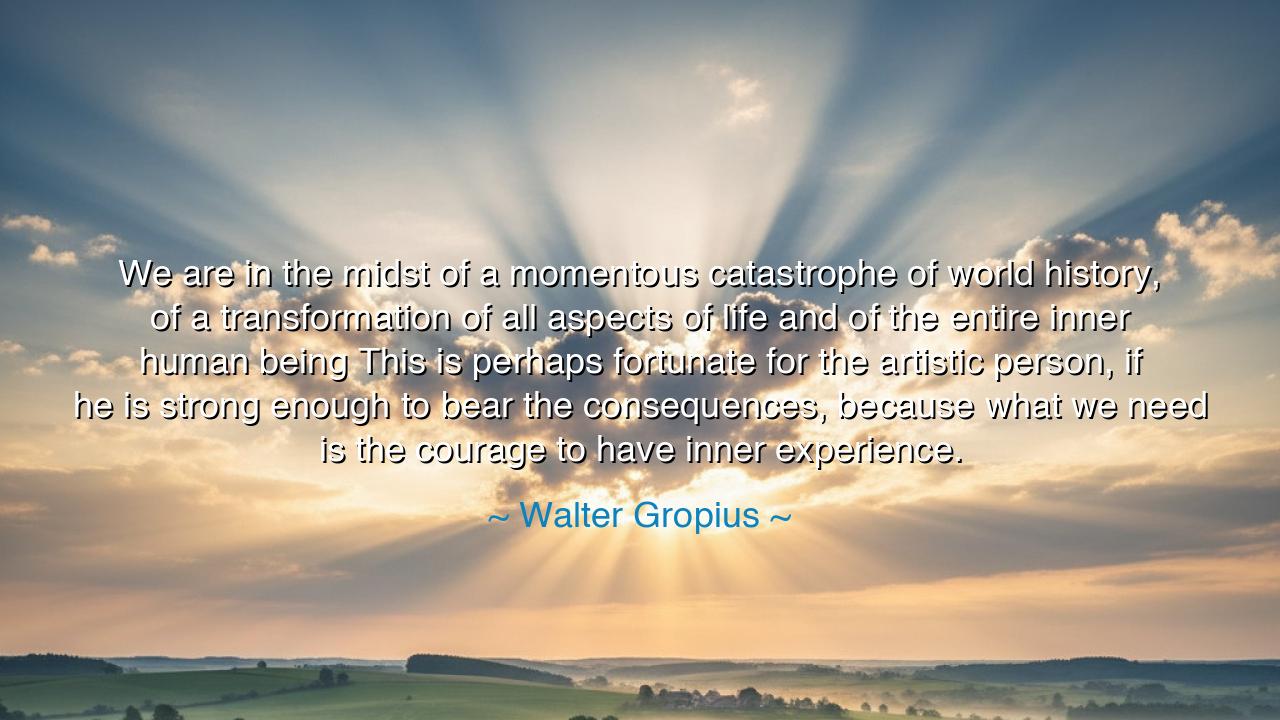
We are in the midst of a momentous catastrophe of world history
We are in the midst of a momentous catastrophe of world history, of a transformation of all aspects of life and of the entire inner human being This is perhaps fortunate for the artistic person, if he is strong enough to bear the consequences, because what we need is the courage to have inner experience.






The visionary architect Walter Gropius, founder of the Bauhaus movement and a man who witnessed both the heights and devastations of human civilization, once wrote: “We are in the midst of a momentous catastrophe of world history, of a transformation of all aspects of life and of the entire inner human being. This is perhaps fortunate for the artistic person, if he is strong enough to bear the consequences, because what we need is the courage to have inner experience.” These words, born from the ruins of war and the collapse of old certainties, speak not merely of art, but of the human soul itself. They are a summons to those who live through turmoil—not to despair—but to awaken, to create, and to endure transformation through courage and vision.
The origin of this profound statement lies in the early twentieth century, an age of upheaval unlike any before it. Europe had been torn apart by the First World War; empires had crumbled; faith in progress and reason had been shattered. The world Gropius knew was not dying—it had already died. And yet, amidst the ashes of destruction, he glimpsed possibility. He saw that from catastrophe could emerge a new form of beauty, a new way of seeing and shaping life. As the founder of the Bauhaus, he sought to unite art, craft, and technology—to rebuild the world through creativity and human spirit. His words are not a lament, but a challenge: in times of collapse, the artist must not retreat. He must turn inward, find strength within the storm, and bring forth something new.
When Gropius speaks of the transformation of “the entire inner human being,” he points to a truth that extends beyond architecture or design. The world changes not only through revolutions of politics or science, but through revolutions of the soul. Every external collapse mirrors an inner one, every rebuilding begins within. He understood that the artist, in the truest sense, is one who dares to feel, to think, and to imagine deeply when the world around him grows numb. But such depth is perilous. To undergo inner experience is to confront one’s fears, to look upon the darkness within, and to still choose to create. It demands courage—the kind not of soldiers, but of souls who refuse to surrender to emptiness.
History gives us many who have walked this path. Consider Vincent van Gogh, who painted through despair and madness, transforming his suffering into light. The world called him broken, yet he was among the first to express, through color and motion, the turmoil and beauty of the human psyche. His art was born from catastrophe—his own and that of his age—but it glowed with divine intensity. Like Gropius, he possessed the courage of inner experience, the willingness to bear the consequences of feeling too deeply. Through that courage, he gave to humanity a mirror of its own soul. Such is the artist’s role in every age of turmoil: to bear what others cannot, and to turn pain into meaning.
Gropius’ message extends beyond the realm of art, for all people are called to be creators in their own right. Every generation faces its own form of catastrophe—wars, disillusionment, spiritual confusion—and each must decide whether to be crushed by it or transformed through it. To have the courage to experience inwardly is to resist the seduction of distraction and numbness, to refuse to flee from discomfort. It means standing before one’s own reflection, one’s own sorrow, and asking: “What can be made from this?” For those who dare, catastrophe becomes not the end, but the furnace of renewal.
This courage is not without cost. The one who chooses to live deeply will suffer deeply. But as Gropius knew, suffering, when accepted with awareness, refines the soul. The shallow heart may survive unscathed, but it remains barren; the heart that endures pain becomes fertile with truth. To be “strong enough to bear the consequences,” as he says, is to allow the fire of change to consume all that is false within us, until only what is essential remains. In this way, art, life, and spirit are reborn together.
So, my child, take this wisdom into your own age, for catastrophe has not vanished—it merely wears new faces. When the world around you shakes, when old beliefs crumble and the future seems uncertain, do not despair. Turn inward. Seek your inner experience. Have the courage to feel, to reflect, to imagine anew. Do not fear transformation—it is the way of life itself. The storm that destroys also cleanses; the fire that burns also purifies.
Thus, the teaching of Walter Gropius stands as both warning and blessing: that we live not merely to endure the changes of history, but to participate in their creation. The artist, the thinker, the dreamer—all are midwives of a new humanity. Through courage, through inner experience, through the union of pain and imagination, the human spirit renews itself. And in every age of darkness, those who dare to create from within become the architects of light.






AAdministratorAdministrator
Welcome, honored guests. Please leave a comment, we will respond soon